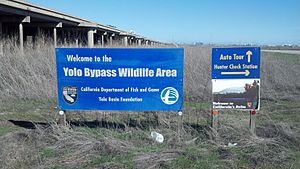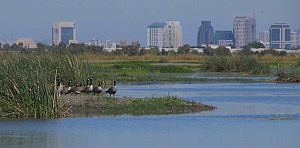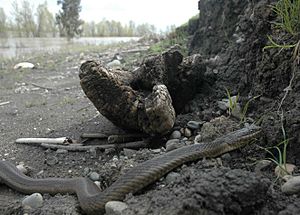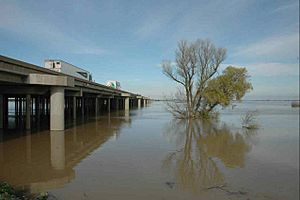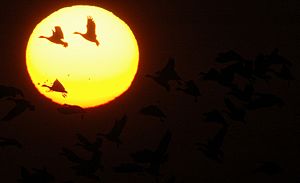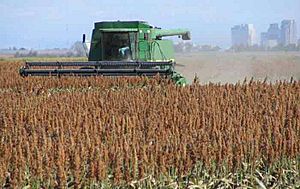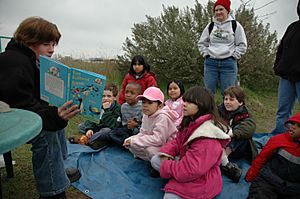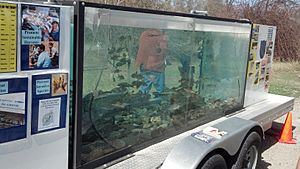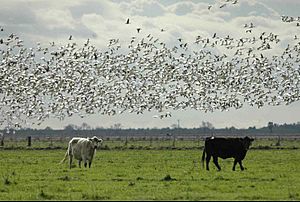Yolo Bypass Wildlife Area facts for kids
The Yolo Bypass Wildlife Area is a special place in Yolo County, California, where nature is protected and helped to grow. It's located within the Yolo Bypass, which is a large area designed to control floods. The California Department of Fish and Wildlife manages this area. Their main goal is to bring back and care for different types of animal homes, called habitats, in the Yolo Basin. This basin is a natural low-lying area in the northern part of the Sacramento-San Joaquin River Delta. The idea for creating this wildlife area came from the Yolo Basin Foundation. Both the California Department of Fish and Wildlife and the Yolo Basin Foundation work together to make this amazing natural resource available to everyone. The wildlife area is located at 38°33′02″N 121°37′35″W / 38.550515°N 121.626291°W.
Contents
History of the Wildlife Area
When Did the Wildlife Area Open?
The Yolo Bypass Wildlife Area first opened to the public in 1997. Before it opened, a lot of hard work went into restoring the land. This restoration was done by an organization called Ducks Unlimited. They used money from the United States government, which was provided through the United States Army Corps of Engineers.
Who Was Vic Fazio?
In 1999, this restored area, which was about 3,700-acre (15 km2) big, was given a special name: the Vic Fazio Yolo Wildlife Area. It was named after a congressman named Vic Fazio. He worked very hard to get the money needed to build and restore this important project.
How Did the Wildlife Area Grow?
The wildlife area got much bigger in 2001. It expanded to more than 16,000 acres (65 km2)! This happened when the state bought more land, including properties known as Glide and Los Rios. These new areas included the 10,000-acre (40 km2) Tule Ranch. The Tule Ranch was a working cattle ranch that also had many special seasonal pools of water called vernal pools.
Habitats and Wildlife
What Kinds of Habitats Are There?
Most of the wet areas in the wildlife area are managed as seasonal wetlands. This means they have a long dry period during the spring and summer. Usually, these ponds are drained around April 1st. This helps a plant called Swamp Timothy to grow. They might get a little water in the summer. Then, in September, they are flooded again. This creates a perfect wetland home for birds that migrate, like waterfowl and shorebirds.
Permanent Wetlands: Homes for Birds and Snakes
Some wetlands are permanent, meaning they are flooded all year round. These areas are usually deeper and have more plants growing in the water. These permanent ponds are very important for young aquatic birds like mallards, common moorhens, and pied-billed grebes. They also provide drinking water for all wildlife and a cool place to escape the hot summer sun. Birds like black-crowned night herons, egrets, and white-faced ibis use this habitat a lot for resting. The threatened giant garter snake also lives in these watery areas.
Upland Areas: Home to Ground-Nesting Birds
Upland habitats are drier areas that are used a lot by birds that build their nests on the ground. These include birds like northern harriers, western meadowlarks, mallards, and ring-necked pheasants. The plants here are usually annual rye grass, curly dock, and wild sunflower. Many rodents live in these areas, which provides food for a large number of birds of prey that visit in the winter.
Vernal Pools: Tiny Worlds of Life
About 1,800 acres (7.3 km2) of natural upland areas are found in the southwest part of the wildlife area. In this section, there are several vernal pools. These are temporary pools that fill with water in the wet season and dry up later. They are home to unique creatures like tadpole shrimp, clam shrimp, and the endangered conservancy fairy shrimp. Rare and endangered plants, such as Heckert's pepperweed and Ferris' alkali milk vetch, also grow here. Grassland birds like the grasshopper sparrow, Savannah sparrow, and burrowing owl live in this area.
Riparian Areas: Trees by the Water
Riparian vegetation refers to the plants that grow along rivers and streams. In this wildlife area, you'll find willows, cottonwoods, black walnut trees, and other tree species. Birds that nest here include Swainson's hawks, great-horned owls, wood ducks, tree swallows, and black phoebe. This habitat is very important for birds that travel long distances, like blue grosbeaks, ash-throated flycatchers, and many types of warblers. Most of these riparian plants are found along Putah Creek in the middle of the wildlife area.
Other Important Uses
Flood Control: Protecting Cities
The Yolo Bypass is a huge 59,000-acre (240 km2) flood control channel. Its main job is to protect cities like Sacramento from flooding. The wildlife area was created knowing that it would always work together with this important flood control job. Because of this, there are rules about how many plants and trees can grow in certain parts of the wildlife area. These rules help make sure that water can flow freely during floods.
The wildlife area is located at the northern end of the Yolo Basin, where Putah Creek flows into the Yolo Bypass. This part of the Delta is called the Putah Sinks. It's home to many different kinds of wildlife that live in seasonal wetlands, permanent wetlands, riverside forests, uplands, vernal pools, and even farm fields.
Agriculture: Farming for Wildlife
One interesting thing about the wildlife area is how much farming is done there. This farming helps reach the goals for wildlife habitats and also brings in money to help run the area. In the northern parts of the wildlife area, rice is grown. After the rice is harvested, the fields are flooded. This attracts thousands of waterfowl and shorebirds, and people can see them easily from Interstate 80. Wildlife managers have a system where they rotate crops in the rice fields. Every three years, a field is left fallow, meaning nothing is grown. During this time, the field is flooded in the mid-summer months to create a home for migratory shorebirds.
Public Use: Visiting and Learning
The wildlife area is open every day, except Christmas, for people to watch wildlife and go fishing. Volunteers from the Yolo Basin Foundation lead tours every second Saturday of the month. The Yolo Basin Foundation and Fish and Wildlife also offer other activities, like bat tours, open houses, and a series of talks in the fall and winter.
During the fall and winter, the California Department of Fish and Wildlife allows hunting for waterfowl, pheasant, and mourning doves in specific areas.
The "Discover the Flyway" education program brings about 4,000 students each year to learn about wetlands and visit the wildlife area. California Duck Days is a yearly wildlife festival held every February. It includes educational displays and field trips to see wildlife. Other activities at the festival include trout fishing for kids, a mobile aquarium, and displays of live birds of prey.
Tule Ranch: A Special Part of the Area
The Tule Ranch is a large 10,000-acre (40 km2) ranch that was bought in 2001. This purchase was a big part of expanding the wildlife area. The Glide family had owned this ranch for over 130 years. Since it was bought, about 5,000 acres (20 km2) of new wetlands have been restored on this property.
What Can You See at Tule Ranch?
The western part of the Tule Ranch has many vernal pools within mostly natural grasslands. In the spring, you can see amazing displays of wildflowers here! Some notable grassland birds that breed in this area include the grasshopper sparrow, Savannah sparrow, and western meadowlark. A well-known landmark in the area is the Umbrella Barn, a large wooden barn that is more than 100 years old.
Cattle and Geese at Tule Ranch
The Tule Ranch also has a large program where cattle graze. Some fields are managed to have the most nutrition for the cattle, with plants like burr clover. These fields also provide important food for migratory snow geese and white-fronted geese. Cattle are a key tool used to manage the vernal pool habitat. When they eat the thick stands of annual rye grass, it helps native wildflowers grow better in this area. This leads to beautiful wildflower blooms every spring. At the very bottom of the Tule Ranch is the Fireman's Club. This is a square mile of land that has a historic slough, which is a muddy channel that once drained into the Yolo Basin. Employees from the Dixon Fire District used to hunt on this land for many years in exchange for their emergency services to the ranch.


